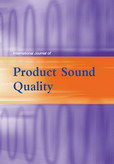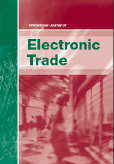Explore our journals
Browse journals by subject
Research picks
- I'm only human, after all
Where are the humans in human-centred design? That is the question researchers answer in their paper in the Journal of Design Research.
In an area increasingly defined by its responsiveness to human needs, a new piece of research from the University of Michigan suggests that the act of drawing a person into a design sketch can prompt a deeper and more sustained consideration of the human experience. The findings offer a quietly transformative approach to a long-standing challenge: how to ensure that design thinking remains rooted in the lives of the people it aims to serve. This is critical in the earliest, most abstract phases of idea generation.
Human-centred design, a methodology that emphasizes empathy with users and attention to their emotional, social, and physical experiences, is now common across many disciplines, from product development and architecture to public services. Yet despite this, it remains difficult to realize in practice. Designers, particularly when working independently or under tight constraints, often struggle to take the human angle into account. This later manifests itself as the end-product being disconnected from users.
The new research tackles this dilemma by introducing a subtle but purposeful intervention. In two empirical studies involving student designers, participants were first asked to generate design ideas as they normally would. In a second round, they were given one additional instruction: to include a visual representation of a person in every sketch they produced.
While the change might seem trivial, almost naïve and childlike, its impact was not. The researchers saw a noticeable shift in cognitive patterns as the student engineers in each group worked. Those that included people in their sketches began to discuss their ideas differently. They speculated more readily about how users would physically interact with a product, how the design might make someone feel, and what implications it might have for others beyond the immediate user. This is obviously a positive effect in terms of ensuring that the final design is connected to human reality rather than disconnected.
Murphy, L.R., Makhlouf, T., Daly, S.R. and Seifert, C.M. (2025) 'Where are the humans in human centred design? Intentionally representing people during idea generation deepens consideration of needs', J. Design Research, Vol. 22, No. 5, pp.1–26.
DOI: 10.1504/JDR.2025.145837 - Pores for thought when it come to carbon capture
A new life-cycle assessment comparing the production impacts of three materials used in carbon dioxide capture technology has highlighted the environmental trade-offs involved in using such materials. The research, published in the International Journal of Global Warming, analysed the emissions associated with manufacturing, a so-called "cradle-to-gate" analysis. The results offer new insights into whether the use of such materials can truly be sustainable in part of how we address climate change.
Namra Mir, Yusuf Bicer, Fadwa El-Mellouhi, Elumalai Palani, Satyanarayana Bonakala, and Abdulkarem I. Amhamed of Hamad Bin Khalifa University, Doha, Qatar, have looked at various porous materials, which can "adsorb" gases from the air. These include natural minerals known as zeolites and their synthetic counterparts, metal-organic frameworks (MOFs). Depending on the exact chemical structure of these materials, they can be produced to adsorb specific gases, such as the greenhouse gas carbon dioxide, in preference to others.
As global efforts to reach net-zero emissions are intensifying, so carbon dioxide capture technology continues to be of interest. It could be used to offset emissions from industrial and other sectors that would be very hard to decarbonize, such as cement production and transport.
The study focused on three porous materials with potential for carbon capture. Specifically, the team looked at TCM-14, referred to as MOF-1, and two hybrid zeolite-based materials, zeolite 13X with diethylenetriamine (MOF-2) and zeolite A with methanol (MOF-3). They then calculated the emissions associated with producing these materials for use in carbon capture technology.
Among the three, MOF-1 had the lowest environmental footprint at 3.5 kg carbon dioxide equivalent per kilogram of material. The two hybrid zeolite materials had significantly higher emission potential at around 14 kg of carbon dioxide each per kilogram manufactured. This suggests that despite its greater chemical complexity, MOF-1 may be the more sustainable option in terms of its initial environmental burden.
However, the team points out that despite this advantage, manufacturing MOF-1 is an energy-intensive process because it has to be carried out at a very high temperature. For the zeolite-based materials, the chemical modifiers used can lead to even worse manufacturing emissions, with one particular additive used to improve adsorption, leading to carbon dioxide emissions of well over 40 kilograms per kilogram of adsorbent material produced.
The work emphasises that we cannot evaluate a technology developed to combat climate change solely on its performance, we must take into account the energy and emissions costs as well as the resources costs of manufacturing and maintaining that technology.
Mir, N., Bicer, Y., El-Mellouhi, F., Palani, E., Bonakala, S. and Amhamed, A.I. (2025) 'Life cycle assessment of sustainable metal-organic frameworks and zeolites', Int. J. Global Warming, Vol. 36, No. 1, pp.23–33.
DOI: 10.1504/IJGW.2025.145674 - Step off the gas
New research has shed light on a critical obstacle facing efforts to reduce carbon emissions, the willingness of drivers to accept higher fuel costs. A pair of simultaneous surveys, designed to explore this issue, found that consumers' readiness to endure economic sacrifices depends heavily on their understanding of climate change's tangible effects. Details of the results and analysis can be found in the journal Interdisciplinary Environmental Review.
In the study, participants were divided into two groups. One, known as the "treatment group," was asked to read a short article outlining the destructive impacts of climate change across the USA. The other group, the "control group," received no such information. The contrast between responses from the two groups was stark. Those exposed to the information were significantly more willing to accept increased fuel prices in the interest of reducing carbon emissions, while those without that context expressed little willingness, if any, to do so.
The findings, from John McCollough of Lamar University in Beaumont, Texas, USA, highlight the importance of public awareness in environmental policymaking. Carbon emissions are described by economists as a "public bad," a term referring to harmful by-products of everyday activities. Burning fossil fuels for transport and the associated carbon emissions impose costs on society at large. To mitigate a "public bad", one widely used strategy is to raise the associated costs through taxation. In this instance, the logic is that by making carbon-intensive activities more expensive, individuals and businesses will be driven to change their behaviour. They might drive less or invest in cleaner vehicles, or even adopt alternative forms of transport.
The strategy is embodied in the concept of a carbon or fuel tax. Economists broadly regard such taxes as among the most efficient, cost-effective, and administratively simple means of reducing greenhouse gas emissions. The USA remains an outlier among developed economies. It has the lowest fuel taxes among member countries of the Organisation for Economic Co-operation and Development and ranks high in per capita carbon emissions.
The relationship between fuel taxation and emissions is well-documented. Countries that impose higher taxes on fuel consistently record lower per capita levels of carbon dioxide emissions. Yet despite its economic efficiency, raising fuel prices is politically contentious. Higher taxes would mean higher household expenses, potentially reshaping spending patterns and lifestyle choices. While some households might reduce driving, purchase fuel-efficient vehicles, or shift to public transit, but without increased understanding of why such changes are necessary, there will inevitably be pushback from the public.
The research suggest that designing effective climate policies is not enough. Governments need to communicate the reality of climate change and connect directly with people's experiences. The success of carbon pricing initiatives, and possibly of broader climate strategies, depends not only on sound economic reasoning but also on cultivating public trust and engagement.
McCollough, J. (2025) 'Environmental awareness and consumers' willingness to accept higher fuel prices to reduce carbon emissions', Interdisciplinary Environmental Review, Vol. 24, No. 2, pp.112–123.
DOI: 10.1504/IER.2025.145774 - Microplastic detection
A study in the Interdisciplinary Environmental Review has looked for the presence of microplastics in drinking water sources in Southern India. The work provides new evidence of the spread of plastic pollution and its increasing potential effect on human health. I. Ronald Win Roy and A. Stanley Raj of Loyola College in Chennai, India, analysed tap and tank water in Chennai, focusing on areas near the heavily polluted Cooum River and Great Salt Lake. They found microplastic particles in almost every sample tested.
Microplastics are defined as plastic fragments smaller than five millimetres. They are usually formed through the breakdown of larger pieces of plastic waste through exposure to sunlight, water, and friction. They have been detected in almost every ecosystem from the remote Arctic ice to the deepest parts of the ocean, which is of obvious broad environtmental concern. However, their presence in drinking water is a serious issue with a potentially even more direct effect on public health.
This is the first study of its kind in Southern India and comes at a time when global plastic production is of even more concern than ever before. In 1970, global production stood at 30 million tonnes, by 2020, plastic production had reached 380 million tonnes. Forecasts suggests that figure will have reached 600 million tonnes annually by 2050. As plastic use intensifies around the world, waste management systems, particularly in rapidly urbanizing regions, are struggling to keep pace. The result is that plastic debris is increasingly infiltrating both natural and the built environments.
The presence of microplastics in the environment and in drinking water is troubling in itself, but it is their potential to act as vectors for toxic substances that raises even more concern. Fat-soluble compounds can be absorbed on to or even into synthetic polymer particles. Such compounds might include persistent organic pollutants with potentially carcinogenic or endocrine-disrupting effects. Furthermore, microplastics might act as hosts for pathogenic microbes or transport toxic heavy metals.
Once ingested, any toxic payload released in the body might then have detrimental effects on health. Given that tests on blood, placental tissue, and even lung samples have already demonstrated the presence of microplastics in humans. Microplastic contamination is becoming a defining feature of the Anthropocene. The development of detection tools, as demonstrated in this study, is urgently needed so that we can more clearly understand the problem and hopefully devise solutions.
Roy, I.R.W. and Raj, A.S. (2025) 'Identifying microplastic contamination in drinking water: analysis and evaluation using spectroscopic methods', Interdisciplinary Environmental Review, Vol. 24, No. 2, pp.97–111.
DOI: 10.1504/IER.2025.145768 - Car dealership nexus connection
A study in the International Journal of Business Forecasting and Marketing Intelligence has looked at the automotive market in Zambia and found that after-sales service is a crucial, though often-overlooked, factor in shaping customer satisfaction and influencing word-of-mouth recommendations.
As car ownership in this developing nation grows and consumer expectations rise, the findings from Shem Sikombe of Copperbelt University, in Kitwe, Zambia, show that dealerships can play a role not only in selling vehicles, but also in cultivating long-term relationships with customers.
Sikombe carried out a structured survey distributed among customers at branded car dealerships in various locations. His analysis of the data offers a detailed examination of how after-sales service functions in an emerging market context. The work used hierarchical regression and a statistical method known as the Hayes bootstrapping mediation analysis to determine the indirect impact of one variable on another. The results dissect the effects of maintenance facilities, warranties, and the quality of spare parts.
As such, Sikombe found that maintenance facilities and warranties have a clear and statistically significant positive effect on customer satisfaction. In practical terms, this means that when a customer believes their car is being properly serviced and that the dealership stands firm behind its warranty promises, they are more likely to feel satisfied with the overall buying experience. This echoes what has been found in in more established markets, where service reliability and perceived value are closely tied to customer trust.
That third factor, the quality of spare parts, produced a more ambiguous result. Statistically, there was no real correlation between parts quality and customer satisfaction. However, the issue may lie less with the quality of the parts themselves and more in their cost and availability. Delays in obtaining spares and dissatisfaction with high prices, suggests that supply bottlenecks and pricing policies could be harming the reputation of dealerships. These various factors all influence customer satisfaction and how overall service quality correlates with word-of-mouth promotion.
Dealerships must ensure customer satisfaction as much as they can control those factors. In markets like Zambia, where consumer decisions are strongly influenced by peer recommendations, this form of informal marketing carries particular weight.
Sikombe, S. (2025) 'Investigating after-sales service, customer satisfaction and word-of-mouth nexus: evidence from a branded car dealership', Int. J. Business Forecasting and Marketing Intelligence, Vol. 10, No. 2, pp.199–213.
DOI: 10.1504/IJBFMI.2025.145289 - Encryption adds up, securely
Researchers have developed a method to speed up privacy-preserving computations, allowing multiple parties to jointly perform calculations on sensitive data without revealing their individual inputs—and without any third party being able to reconstruct the original data from the results. Details are reported in the International Journal of Applied Cryptography.
The team has focused on a key technical challenge in the field of cryptography. How to perform floating-point arithmetic securely and at scale. Floating-point arithmetic is used by computers to handle real numbers, whether very large or very small, using a codified version of scientific notation so that long strings of zeroes to make a number very small or very large are not needed. This latest advance has the potential to accelerate research and development in privacy-sensitive domains such as health data analysis, financial modelling, and machine learning, without compromising confidentiality.
Secure multi-party computation (MPC) and homomorphic encryption are techniques designed to address the problem. They allow computations to be carried out on encrypted or distributed data, so that no party learns anything about the inputs from the other parties beyond the final result. However, MPC systems struggle with floating-point numbers in terms of performance. They could use fixed-point numbers instead, but that would compromise the precision of the data through rounding errors.
The new research directly addresses the problem by introducing a more efficient way to perform secure floating-point addition, one of the most fundamental operations in numerical computing. The key innovation lies in a protocol that allows many additions to be carried out simultaneously, rather than one at a time. In tests, the approach is 13 times faster than state-of-the-art techniques. Moreover, it uses existing MPC frameworks. The protocol preserves the privacy of all intermediate values and requires no specialised hardware or novel cryptographic assumptions.
Veugen, T., Wezeman, R., Amadori, A., Bootsma, S. and Kamphorst, B. (2025) 'Secure addition of floating points', Int. J. Applied Cryptography, Vol. 5, No. 5, pp.1–11.
DOI: 10.1504/IJACT.2025.145709 - It's a dirty job, but someone's got to do it
Research in the International Journal of Economics and Business Research has looked at how workers in socially stigmatized or emotionally taxing occupations, colloquially referred to as "dirty work", cope with the psychological burden of their roles. The research also considers the factors that might help such workers stay in such careers.
Xiao Xiao and Sze-Ting Chen of the Chinese International College at Dhurakij Pundit University in Bangkok, Thailand, surveyed a thousand or so employees across a variety of industries. They identified the psychological mechanisms that connect feelings of stigma to intentions to leave a job, and importantly, what can disrupt that pattern.
The term "dirty work" refers to jobs that society often views as unpleasant, morally ambiguous, or low-status. This includes roles in sanitation, care work, adult entertainment, and other professions marked by social disapproval or discomfort. These occupations, though often essential, are frequently associated with low wages, limited upward mobility, and entrenched negative stereotypes.
The team found that employees who perceive their work as dirty are more likely to consider leaving their profession. Central to this is the concept of "learned helplessness". This is a known psychological state in which individuals, after repeated negative experiences, begin to feel powerless to change their circumstances. This feeling of futility acts as a psychological bridge between the perception of one's job as degrading and the desire to abandon it.
However, the team also found two powerful counterpoints to this effect, what they refer to as "career calling" and "job crafting". Career calling refers to an individual's deep-seated belief that their work serves a meaningful purpose or contributes to the greater good, despite the perception of it as "dirty work". Workers who see their roles in this light, such as viewing care work as vital to community wellbeing, are more resistant to the emotional toll of societal stigma and more inclined to stay.
That other factor, job crafting, refers to how employees might take steps to reshape aspects of their work environment. This might include altering the nature of their tasks, reframing their job narratives, or seeking more meaningful relationships with colleagues or clients. A hospital caretaker might come to see their role as foundational to public health, while a worker in the adult entertainment industry may emphasize their artistic expression or emotional labour. By tailoring their work experience, individuals can reduce any feelings of helplessness and strengthen their professional identity.
From an organizational standpoint, the implications of understanding the psychological costs of stigmatized work could be crucial for employee morale and retention. Employers can intervene by offering greater autonomy, encouraging task redesign, and reinforcing the social importance of such roles.
Xiao, X. and Chen, S-T. (2025) 'Unique insights: the mediating role of learned helplessness on the influence of perceived dirty work on career transition intentions, and the moderating role of job crafting and career calling', Int. J. Economics and Business Research, Vol. 29, No. 11, pp.1–30.
DOI: 10.1504/IJEBR.2025.145705 - Decisions, decisions, decisions
A newly developed framework could reshape the way scholars and professionals understand the complex processes behind human decision-making. Developed through a multidisciplinary effort and validated with data from German professionals across sectors, the RIDMS (Rational and Intuitive Decision-Making Styles) model offers a comprehensive, evidence-based structure for assessing both analytical and instinctive aspects of how people make choices. The new framework is discussed in detail in the International Journal of Economics and Business Research.
Markus A. Launer of the Ostfalia University of Applied Sciences, Ostfalia, Suderburg, Germany, and Fatih Çetin of the Universite Caddesi in Ankara, Turkey introduce RIDMS as having ten distinct dimensions. Together, these characteristics map out the range of rational and intuitive strategies people might use when making decisions. These dimensions are designed to be applied across disparate areas of decision-making, from healthcare and education to emergency response and organizational leadership. As such, they provide researchers and practitioners with a more nuanced, adaptable tool than has previously been available.
Intuitive decision-making has remained little studied. While individuals frequently rely on gut feelings, emotional cues, or accumulated experience, especially in high-pressure or uncertain environments, many existing models of decision-making have only vaguely defined such intuitive decision-making. RIDMS could change that by breaking down intuition into its components and recognising how each is influenced by context and experience.
Among its ten dimensions, RIDMS includes not only the typical logical-planning methods, but also less linear processes, such as the phenomenon of incubation, where decisions seem to crystallise gradually over time. It also accounts for socially distributed decision-making, in which individuals draw heavily on trusted peers or mentors. In doing so, the model recognises that decision-making is often embedded in a social context, rather than occurring in isolation.
The RIDMS model incorporates insights from a broad spectrum of disciplines, including cognitive psychology, neuroscience, management theory, and behavioural science. The team thus explains that it is empirically grounded and has been validated statistically.
Launer, M.A. and Çetin, F. (2025) 'A new instrument for the rational and intuitive decision-making styles – RIDMS', Int. J. Economics and Business Research, Vol. 29, No. 11, pp.31–51.
DOI: 10.1504/IJEBR.2025.145706 - Boosting business resilience digitally
A review in the International Journal of Business Innovation and Research has looked at the recent literature to see how large companies can become more resilient by using digital tools and technology. The researchers found that being flexible, making decisions based on data, and involving all stakeholders are the main ways to boost resilience. They add that the use of good knowledge-sharing systems also makes a big difference, rather than simply using advanced technology.
Large companies face a paradox: while digital transformation holds enormous promise for strengthening their resilience, many, nevertheless, fail to achieve their intended outcomes. To find out why this might be, Moris Krismas Tarigan, Togar Mangihut Simatupang, and Yuni Ros Bangun of the Institut Teknologi Bandung, Indonesia, have carried out a comprehensive review of research published between 2020 and 2024. The team used the digital maturity model, the Industry 4.0 framework, and dynamic capabilities theory to help them reveal the various factors affecting organisational resilience.
Organisational resilience refers to a company's ability to anticipate, adapt to, and recover from disruptions, whether triggered by economic shocks, global pandemics, supply chain breakdowns, or rapid technological changes. Digital transformation involves a fundamental rethinking of business operations through the adoption and integration of digital technologies. Digital transformation can have powerful effects, but this review shows that the true value lies not in technical capabilities alone, but in how effectively they are embedded within an organisation's culture, strategy, and decision-making systems.
The researchers found that there are three important mechanisms through which digital transformation boosts organisational resilience in large companies. The first is a marked improvement in operational flexibility, meaning companies can adjust processes, production, and service delivery more rapidly in response to changing conditions. The second is that data-driven decision-making is improved, allowing companies to make faster, more informed, and adaptive choices during times of uncertainty. The third is that stakeholder engagement is increased, which strengthens collaboration and communication with partners, suppliers, and customers. Overall, these factors help companies respond more effectively to disruption and foster long-term adaptability.
In addition, the review also found that organisational learning has an important role. Companies that invest in knowledge management system, tools and practices that enable the capture, sharing, and application of knowledge, can enhance the positive effects of digital transformation. In other words, technological sophistication alone is not enough to build resilience, but rather an organisation needs to have the capacity to learn from experience.
Tarigan, M.K., Simatupang, T.M. and Bangun, Y.R. (2025) 'Building resilience through digital transformation: a systematic literature review and comprehensive framework for large enterprises', Int. J. Business Innovation and Research, Vol. 36, No. 5, pp.1–28.
DOI: 10.1504/IJBIR.2025.145665 - Tech transforms teaching
Research in the International Journal of Computational Systems Engineering has implications for how advanced technology is integrated into the modern classroom. The work shows how education is moving way beyond the traditional lecture-based teaching model and touches on how the "smart" classroom environment might make use of many of the much-hyped tools, such as artificial intelligence (AI), big data analytics, virtual reality (VR), and cloud computing to enhance student-centred, independent learning.
According to the work from Qingping Luo of Changsha Social Work College in ChangSha, China, smart classrooms might be described as technology-enhanced learning spaces designed to adapt to the individual needs of students. These environments encourage learners to explore, research, and engage with content at their own pace using digital platforms that offer interactive media, online assessments, and live collaboration tools. The flexibility offered by the smart classroom not only sits well with current educational theory but also reflects a broader shift in teaching towards active and personalized learning.
At the heart of the digital transformation of education is the integration of internet-connected equipment such as tablets and laptops into the educational milieu. This connectivity allows students to carry out real-time research, collaborate between different locations, and access learning resources that would otherwise be unavailable to them.
The research emphasizes that these changes are not merely a matter of convenience. In fact, it demonstrates measurable improvements in learning outcomes. For instance, subject-specific platforms are being developed to enhance instruction in areas such as music education, using AI-driven systems that support interactive learning. These systems not only present information but also analyse student responses through tools such as classification, keyword retrieval, and visual mapping. These are all techniques that can help reinforce comprehension and encourage critical analysis.
Importantly, the research also introduces a framework that might allow the impact on education of these new approaches to be evaluated. Indeed, controlled experiments comparing students in smart classrooms with peers receiving traditional instruction suggest that those using the technology-enhanced methods do perform better, especially where self-guided exploration and inquiry are encouraged and facilitated by the technology.
Luo, Q. (2025) 'Methodological strategies for control experiments in independent teaching and learning environment', Int. J. Computational Systems Engineering, Vol. 9, No. 7, pp.1–10.
DOI: 10.1504/IJCSYSE.2025.145623
News
Prof. Antonio Formisano appointed as new Editor in Chief of International Journal of Rapid Manufacturing
Prof. Antonio Formisano from the University of Naples in Italy has been appointed to take over editorship of the International Journal of Rapid Manufacturing.
Eight Inderscience journals announced as open access-only titles
We are pleased to announce that the following titles
- International Journal of Business Excellence
- International Journal of Business Innovation and Research
- International Journal of Business Information Systems
- International Journal of Critical Infrastructures
- International Journal of Indian Culture and Business Management
- International Journal of Information and Coding Theory
- International Journal of Services and Operations Management
- International Journal of System of Systems Engineering
are now Open Access-only journals. All accepted articles submitted from 23 April 2025 onwards will be Open Access, and will require an article processing charge of US $1600.
Five inderscience journals announced as open access-only titles
We are pleased to announce that the following titles
- International Journal of Computational Complexity and Intelligent Algorithms
- International Journal of Electronic Finance
- International Journal of Electronic Security and Digital Forensics
- International Journal of Managerial and Financial Accounting
- International Journal of Modelling in Operations Management
are now Open Access-only journals. All accepted articles submitted from 17 April 2025 onwards will be Open Access, and will require an article processing charge of US $1600.
International Journal of Power and Energy Conversion is now an open access-only journal
We are pleased to announce that the International Journal of Power and Energy Conversion is now an Open Access-only journal. All accepted articles submitted from 18 March 2025 onwards will be Open Access, and will require an article processing charge of US $1600.
Prof. Varun Gupta appointed as new Editor in Chief of International Journal of Computer Aided Engineering and Technology
Prof. Varun Gupta from Gisma University of Applied Sciences's Multidisciplinary Research Centre for Innovations in SMEs in Germany has been appointed to take over editorship of the International Journal of Computer Aided Engineering and Technology.




